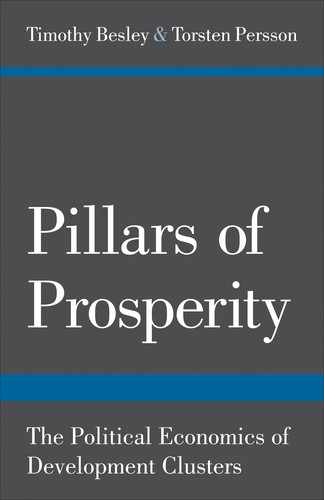Contents
CHAPTER 1 Development Clusters
2.1.2 Politically Optimal Policy
2.1.3 Fiscal-Capacity Investments
2.1.4 Normative Benchmark: A Pigouvian Planner
2.2.1 Microfoundations for Fiscal Capacity
2.2.2 More General Models for Public Goods
2.2.3 Polarization/Heterogeneity
2.2.5 Differences in Group Size
2.2.7 From Trade to Income Taxes
2.2.8 An Infinite-Horizon Model
2.3 Empirical Implications and Data
3.1 The Core Model with Legal Capacity
3.1.1 Politically Optimal Policy
3.1.2 Investments in State Capacity
3.2.1 Microeconomic Foundations
3.2.3 Private Capital Accumulation
3.2.4 Predation and Corruption
3.3 Empirical Implications and Data
4.1 The Core Model with Political Violence
4.1.3 Investments in Political Violence 179 4.1.4 Empirical Implications
4.2.2 Polarization, Greed, and Grievance
4.2.4 Conflict in a Predatory State
4.2.5 Investing in Coercive Capacity
4.3 From Theory to Empirical Testing
4.4.2 Cross-Sectional Correlations
5.1 State Capacity in the Comprehensive Core Model
5.1.1 Equilibrium Political Turnover
5.1.2 Investments in State Capacity Revisited
5.4 Putting the Pieces Together
CHAPTER 6 Development Assistance
7.1 The Core Model and Political Reform
7.1.1 Political Reform under a Veil of Ignorance
7.1.2 Strategic Political Reform
7.2.1 Micropolitical Foundations for θ
7.2.2 Micropolitical Foundations for γ
7.3 Political Reform in Practice
8.1.1 Answers to the Three Main Questions
8.1.2 Our Analysis and Traditional Development Research
8.2 The Pillars of Prosperity Index
